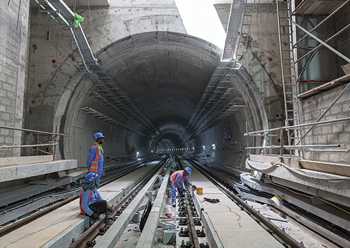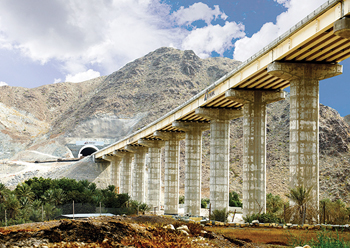
 Dubai Metro ... Acciona was involved in the design and construction of the 15-km-long Route 2020 metro line.
Dubai Metro ... Acciona was involved in the design and construction of the 15-km-long Route 2020 metro line.
Railway construction in the Middle East has witnessed significant progress in recent years, with countries in the region recognising the importance of a robust transportation infrastructure for economic development, regional integration, and sustainable growth. The Middle East’s strategic location and its role as a global hub for trade and tourism make the development of railway networks crucial.
Railway construction has a transformative impact in the Middle East as it provides enhanced connectivity and integration, promotes economic diversification and sustainable development, and facilitates efficient movement of goods.
Enhanced Connectivity and Integration
One of the key benefits of railway construction in the Middle East is the enhanced connectivity it brings. By connecting cities, regions, and even countries, railways promote regional integration and create a seamless transportation network. Efficient rail systems reduce travel times, facilitate the movement of people and goods, and encourage greater cultural exchange and tourism.
For example in Dubai, Dubai Municipality (before the creation of the Roads & Transport Authority in 2005) identified the need for a rail system to relieve growing motor traffic levels and support continuing urban development based on studies conducted in 1997. The city inaugurated its metro network on September 9 2009, becoming the first urban metro network to run in the Gulf.
Since its public launch, the number of riders who have used the Dubai Metro network has exceeded two billion, according to the RTA. The Red Line has transported 1.342 billion commuters, while the Green Line has served 673.531 million passengers. In 2022, the average daily ridership on the Dubai Metro exceeded 616,000 riders. The RTA now plans to issue the tender documents for the expansion of Dubai Metro in Q4 of this year. Known as the Blue Line, the scheme will extend the existing Red and Green lines.
The extension is part of Dubai’s plans to improve residents’ quality of life by cutting journey times as outlined in its newly approved 20-minute city policy.
 |
|
More than two billion riders have used the Dubai Metro since its launch. |
What is more, Sheikh Mansour Bin Zayed Al Nahyan, the UAE’s Vice President, Deputy Prime Minister and Minister of the Presidential Court, said at the Middle East Rail 2023 that the UAE leadership pays special attention to the development of the transport sector and the railway industry and to the extension of its train network in order to promote development throughout the country, given the vital role that railways play in supporting the economy, promoting investment opportunities and strengthening human and commercial ties. This follows the completion of the Etihad Rail network for freight services earlier this year.
In Saudi Arabia, the Riyadh Metro project – work on which began in 2014 – is in the final stages. The network features six metro lines, 85 stations and will span a total distance of 176 km. It is expected to serve 3.6 million passengers per day once it is fully operational at the start of 2024 at the latest after the completion of the ongoing testing phase. It will be one of the world’s largest public transport network projects.
Saudi Arabia has also recently announced a $1.5-billion contract to connect two components of the Neom futuristic city with 57 km of a high-speed railway network.
The Land Bridge project, also in Saudi Arabia, involves an estimated investment of $20-plus billion to construct over 1,300 km of new rail lines between Jeddah and the Eastern region in addition to a link from Yanbu Industrial City to Jeddah. However, the strategic importance of linking both coasts of Saudi Arabia is evident when examining major rail lines in other developed nations. In Japan, the Shinkansen, also known as the “bullet train,” connects major cities with remarkable efficiency and speed. This extensive network facilitates rapid transportation, fosters economic growth, and enhances regional connectivity. Similarly, the US’ Union Pacific Railroad and BNSF Railway, facilitate the movement of goods across vast distances, contributing to economic development and trade expansion.
These examples demonstrate the economic and logistical benefits of infrastructure projects such as the Land Bridge project, which will dramatically reduce travel time for passenger transport. For instance, the Jeddah-Riyadh rail link will cut travel time from the current 10 to 12 hours by bus to a mere six hours, boosting connectivity and facilitating economic growth.
The Doha Metro is a rapid transit system that was built in time for the 2022 FIFA World Cup. It comprises four lines and 37 stations, with underground and elevated sections spanning a total length of about 76 km. The completion of the Doha Metro will be a vital step in achieving the goal of connecting Qatar and other GCC countries through the GCC rail network.
Promoting Economic Diversification
Railway construction plays a vital role in promoting economic diversification in the Middle East. Historically dependent on oil and gas revenues, countries in the region are actively seeking to diversify their economies by investing in sectors such as tourism, logistics, and manufacturing. The development of railway networks provides the necessary infrastructure to support and drive these sectors. Railways facilitate the efficient movement of goods, lowering logistics costs and enhancing trade competitiveness. They attract foreign direct investment, create employment opportunities, and spur economic growth in sectors related to railway operations and services.
Efficient Movement of Goods
Efficient freight transportation is essential for facilitating trade and supporting economic growth. Railways offer a cost-effective and sustainable solution for transporting goods over long distances. By relieving the burden on congested road networks, railways reduce transport costs and delivery times, making businesses more competitive. Additionally, the transportation of goods by rail is more environmentally friendly, reducing carbon emissions and contributing to sustainable logistics and supply chain management in the region.
Sustainable Development
The development of railway infrastructure in the Middle East aligns with the region’s commitment to sustainable development and environmental conservation. Rail transport produces lower greenhouse gas emissions compared to road or air transport. By shifting a portion of passenger and freight traffic from road to rail, railways help reduce congestion, ease traffic-related pollution and improve air quality in urban areas. Moreover, railways require less land use compared to road networks, minimising the impact on valuable ecosystems and preserving natural habitats.
Catalyst for Regional Development
Railway construction acts as a catalyst for regional development by promoting economic activity and investment in previously underserved areas. The development of rail networks often spurs the growth of towns and cities along the rail corridors. These regions experience increased business opportunities, job creation, and improved access to markets. Railways connect remote regions with urban centres, enabling the development of industries, agriculture, and tourism beyond traditional economic hubs.
Leveraging international best practices plays a crucial role in sustainable development, especially considering the transformation towards an economy based on knowledge and innovation. As part of its expertise, Acciona Transport Solutions has more than 100 years of experience in the construction of railway infrastructure where it has left its mark on hundreds of projects involving more than 3,000 km of railways; more than 100 stations and facilities and more than 600 km of tunnels – in other words facilitating more than 35.3 million travellers per year across the globe.
Railway construction in the Middle East is transforming the region’s connectivity, driving economic development, and promoting sustainable growth. With ongoing and planned railway projects, the Middle East is on a trajectory to build a comprehensive and interconnected railway network that will shape the future of the region, supporting its aspirations for prosperity, sustainability, and global integration.








.jpg)




.jpg)




























.jpg)



































